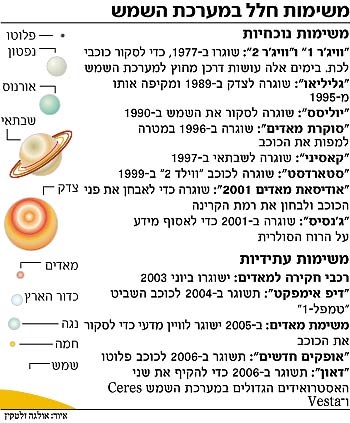NASA will try to provide an answer to the question: Is Pluto a planet?
Larry O'Hanelson, Boston Globe"

Space missions in the solar system
After more than a decade of delays and delays on the part of NASA, Congress and the White House, Pluto - the only planet in the solar system that has not yet been explored by a space shuttle - will receive a visit from Earth. About two weeks ago, NASA gave the final approval for the construction of the "New Horizons" shuttle, whose launch is planned for January 2006 at a cost of about 488 million dollars. It will take more than nine years for the unmanned shuttle to reach Pluto and its moon, Chiron, and after passing them it will reach the mysterious "Kuiper belt" - the outermost asteroid belt of the solar system, which is considered the source of most comets. On the way to its destination, the shuttle will approach the planet Jupiter and collect information about how dust is dispersed in the solar system.
Scientists and engineers have been planning the mission for about 12 years. "This operation has died and been revived several times," says planetary researcher Richard Binzel from the Massachusetts Institute of Technology (MIT). The announcement by the National Academy of Sciences in the US in July 2002 that Pluto and the Kuiper Belt are top priorities in the study of the planets, pushed NASA to finally approve the mission.
Since the shuttle has to fly a long distance and for a longer time than any other space shuttle, its builders use the most reliable technology and will not use experimental tools. In addition, it will carry extremely light equipment.
According to Alan Stern, chief researcher on the mission and director of the space studies department of the Southwest Research Institute in Colorado, due to the relatively light weight of "New Horizons" it will be cheaper to carry out a routine, and it will also be necessary to carry a relatively small amount of explosive material that will be used to make trajectory changes. "We're trying to make it as simple as possible," Binzel says, "so that the spacecraft will be cheap and reliable."
Among other things, the shuttle will carry a camera for light mapping, which will start taking pictures of the star about three months before it approaches it. In addition to this, the shuttle will also be equipped with means to measure the infrared light and the ultraviolet light reflected from the surface of Pluto and Chiron, in order to determine the chemical composition of the rocks and the frozen materials in them. When the shuttle passes by Jupiter in 2007 to accelerate toward Pluto with the help of the star's gravity, it will use the same instruments to capture video of the clouds in Jupiter's atmosphere.
Despite the great advances in astronomy and telescope technology, Pluto is difficult to study from Earth because of its distance and small dimensions. It orbited the Sun at a distance of 5.9 billion kilometers - about 40 times the distance of the Earth from the Sun. The diameter of Pluto is about 2,300 kilometers, about a fifth of the size of the Earth.
One of the questions the shuttle will try to deal with is whether Pluto is indeed a planet. Its size and location in the outermost part of the solar system have caused ongoing controversy surrounding the question. Some claim that it is nothing more than a large comet, as it is made of a mixture of rocks and ice.
Many astronomers believe that Pluto's origin is in the Kuiper belt, so it should be classified as an object and that there may be objects larger than it in the belt. The shuttle will try to examine objects beyond the star, thus understanding its true nature.
